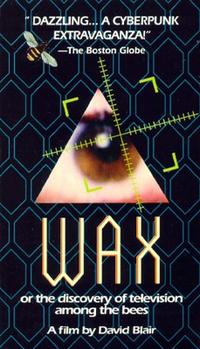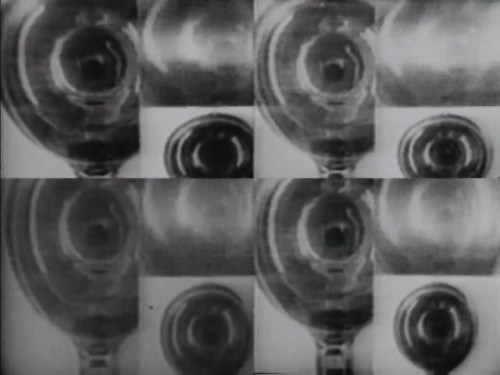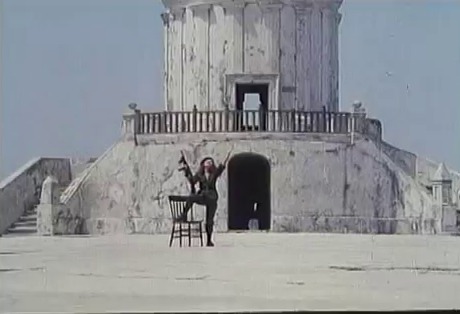 |
| From https://upload.wikimedia.org/wikipedia/en/d/d7/ Wax_or_the_Discovery_of_Television_Among_the_Bees.jpg |
Director: David Blair
Screenplay: David Blair
Cast: Father Bessarion; David
Blair as Jacob Maker; William S. Burroughs as James 'Hive' Maker; Florence Ormezzano
as Allellee Zillah; Meg Savlov as Melissa Maker; Clyde Tombaugh
 In the annuals of American
avant-garde cinema, David Blair's
film has many distinctions. One of the first edited with digital equipment;
when converted to a hypertext known as Waxweb, it was one of the first ever
world wide web sites in existence; and it was the first film streamed online in
the early days of the internet. Blair,
still working into the modern day, took six years on the kind of delirious work
here Thomas Pynchon would look at
with bafflement. As if symbolic to this kind of post-modern reference, as you
follow protagonist Jqacob Maker (the director himself) through hyper
intelligent Mesopotamian bees, the dead living on the moon, and turning into a
living missile to kill a previous incarnation, William S. Burroughs has a small none speaking role as the
protagonist's ancestor, as if to mark this film with greater credibility.
In the annuals of American
avant-garde cinema, David Blair's
film has many distinctions. One of the first edited with digital equipment;
when converted to a hypertext known as Waxweb, it was one of the first ever
world wide web sites in existence; and it was the first film streamed online in
the early days of the internet. Blair,
still working into the modern day, took six years on the kind of delirious work
here Thomas Pynchon would look at
with bafflement. As if symbolic to this kind of post-modern reference, as you
follow protagonist Jqacob Maker (the director himself) through hyper
intelligent Mesopotamian bees, the dead living on the moon, and turning into a
living missile to kill a previous incarnation, William S. Burroughs has a small none speaking role as the
protagonist's ancestor, as if to mark this film with greater credibility.
Wax... whilst made with the technology of the time, with crude CGI
denizens of the world of the dead and an emphasis on an essay film structure
for its fictional and surreal plot, feels ahead of its time in these presidents
and also its subject matter. David Blair,
whilst this is his most well known film, is a figure who still works within
this spectrum outside of conventional cinema, making a sequel of sorts in 2017
with a fifteen episode web series streamed online called The Lost Tribe, and is clearly someone who is always on in terms of
ideas to his work. Wax... in content
is just as unique, not just enough to have this premise of the dead rebelling
and bee television, but in its language and style too, a beauty to its
weirdness.
As mentioned, the film is
structured closer to an audio-video essay, most of the actual footage that
isn't pre-existing material, polygon shapes or photos silent with narration,
tracking of course how James 'Hive' Maker (Burroughs),
a spiritualist who used camera technology to capture the images of ghosts and a
beekeeper, will link to his ancestor Jacob Maker, who helps design intelligent
missile guidance systems, Jacob's own life literally absorbing back into his
forefather's through what is mainly footage of him wandering locations in a bee
keepers suit. From there, as Jacob develops the ability to communicate with
bees and begins slowly to transform, this is depicted in a barrage of stock
footage, overlaid images and basic computer animation, all of which adds an
appropriate dissolution of the barrier between you the viewer and the material
as, trying to absorb it all, the strange narration makes "sense" in
terms of mood, rather than logic, and you find yourself investing in the
material emotionally as a result of the grasping for space within all this
information.
 |
| From https://66.media.tumblr.com/fee6cb10dc5e2619bb2efb9547a 33d31/tumblr_nmh8r5JU971rsc0mvo7_500.jpg |
And it becomes more frenzied and surreal as it goes on. Spoiling plot points is actually difficult because the experience is not the same as describing it second hand, as Jacob has the aforementioned "bee television" implanted in his brain by his own hive of bees, culminating between the story of Cain & Abel being retold in his family, learnt to be his descendents and Jacob's work on intelligent missile guidance software being symbolic, as he himself becomes a living missile in the end who, rather than fleeing to the moon like others, must literally kill himself in one of his multiple co-existing reincarnations in the middle of the first Gulf War. Reality is broken early on, and its actually pathetic for me personally, as a surrealist in mind, for this film to purposely decimate the foundations of it, allowing for Jacob to hop between times, including his grandfather's home of the Garden of Eden, to the idea that souls actually split into multiple living pieces after death like the bees in a hive, all with a soberly spoken narration that is almost deadpan at times with lines that cannot be viewed as anything but intentionally ridiculous from Flair's part.
Frankly, why not love a film
where mad, weird ideas come off this freely, as abstract poetry that just makes sense, especially as it's
still intelligently put together with sub textual links rather than a word
salad of a z-movie. Blair riffs on
real concepts, from the religious to links like Mesopotamia, where the bees are
linked to, being argued to be where Iraq now exists, not lost that this film
was being made in the time of the first Gulf War with a damning view of military
weaponry, more so as the ending has all of our protagonist's forms and their
enemies becoming one and forgoing hatred in a unity. Adding a new ominous side
that, David Flair not knowing this
would happen, intelligent missile guidance systems predate drone technology,
now used in military service and emphasising this sense of violence committed
from a distance the director-writer plays with here.
Blair himself, by accounts, isn't religious but his mix of
Christian and New Age ideas is also compelling, not coming off as a mess but delirious
in a haunting ode of the dead being restless, the weight of the past burdening
the living and crimes having to be dealt with in the afterlife even if it means
breaking reality. Again, the surrealistic side of my heart cheers the later, transcending
physical logic for a profound point, a man able to be both his victim, the
killer, the revenger, two twin women and their siblings, and all within a film
that talks of it with a wise, clever attitude. The density of the material is
like another creator, Jean-Luc Godard,
in how it plays with the form of materials like video and stock footage, but is
its own rich and amazing creation. It is the kind where the technical
obsoletion of some of the materials has actually made its virtues even stronger
in fact.
Abstract Spectrum: Avant-Garde/Mindbender/Surreal
Abstract Rating (High/Medium/Low/None): High
Personal Opinion:
Wax, or the Discovery of Television Among the Bees, available to
watch legally on (what else?) the internet without any cost from the director
himself, is a very strange film to say the least. Absolutely unique but also a
fascinating document in how, made in tandem with the new creation called the World
Wide Web, it is arguably one of the first abstract films ever made to reflect
this new medium which would have a profound impact over the next few decades. Whilst
alien to many internet videos in tone and ideas, its effectively the grandfather
to many odd experimental works like it, somewhat befitting considering it
itself is a film where a man can be his own grandfather and himself as these
films online form a curious heritage to each other.
 |
| From https://66.media.tumblr.com/1fc1a3951c166b7d3769fa69f1 1bebc7/tumblr_nmh8u4hvHS1rsc0mvo2_500.jpg |
















